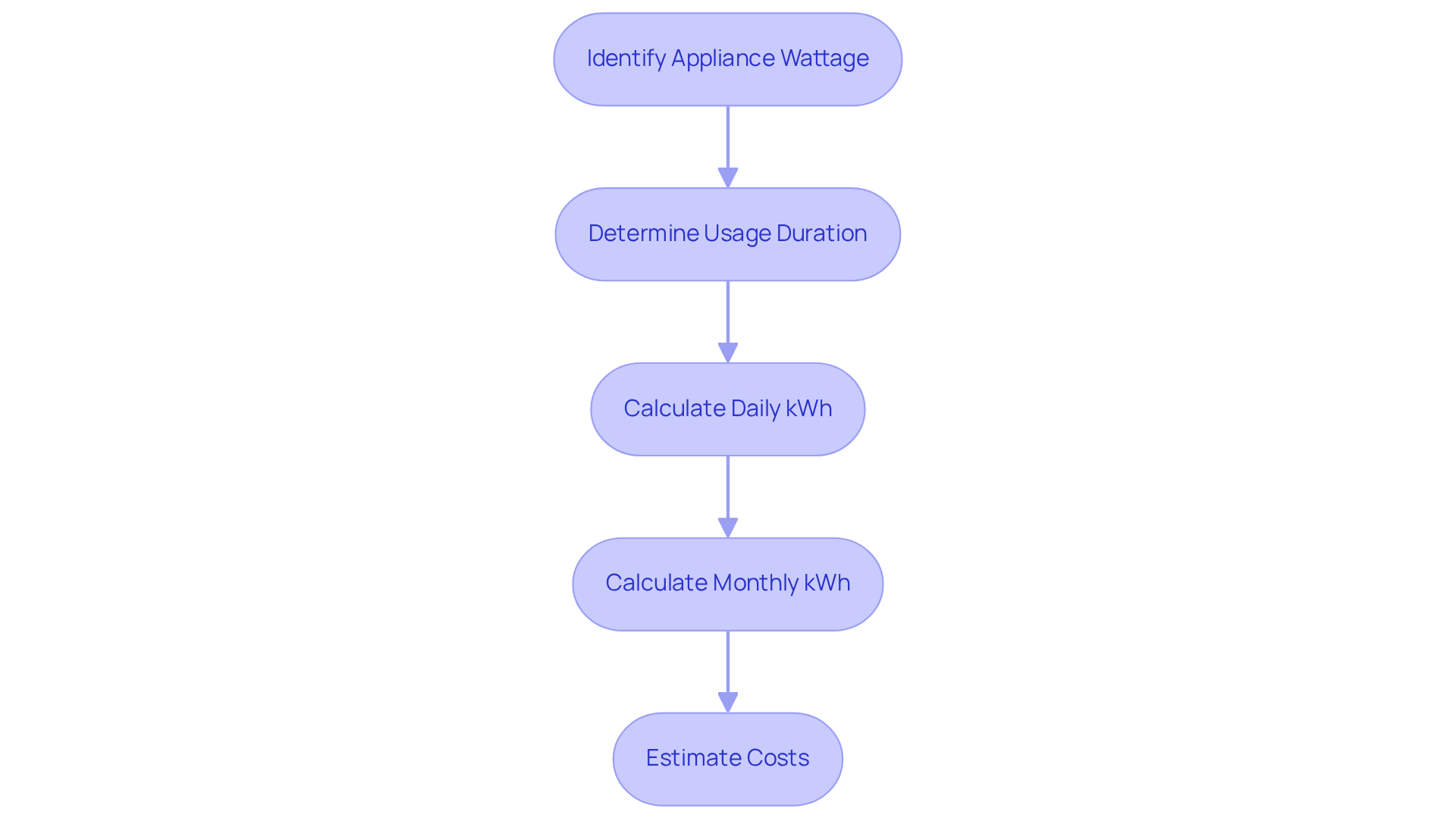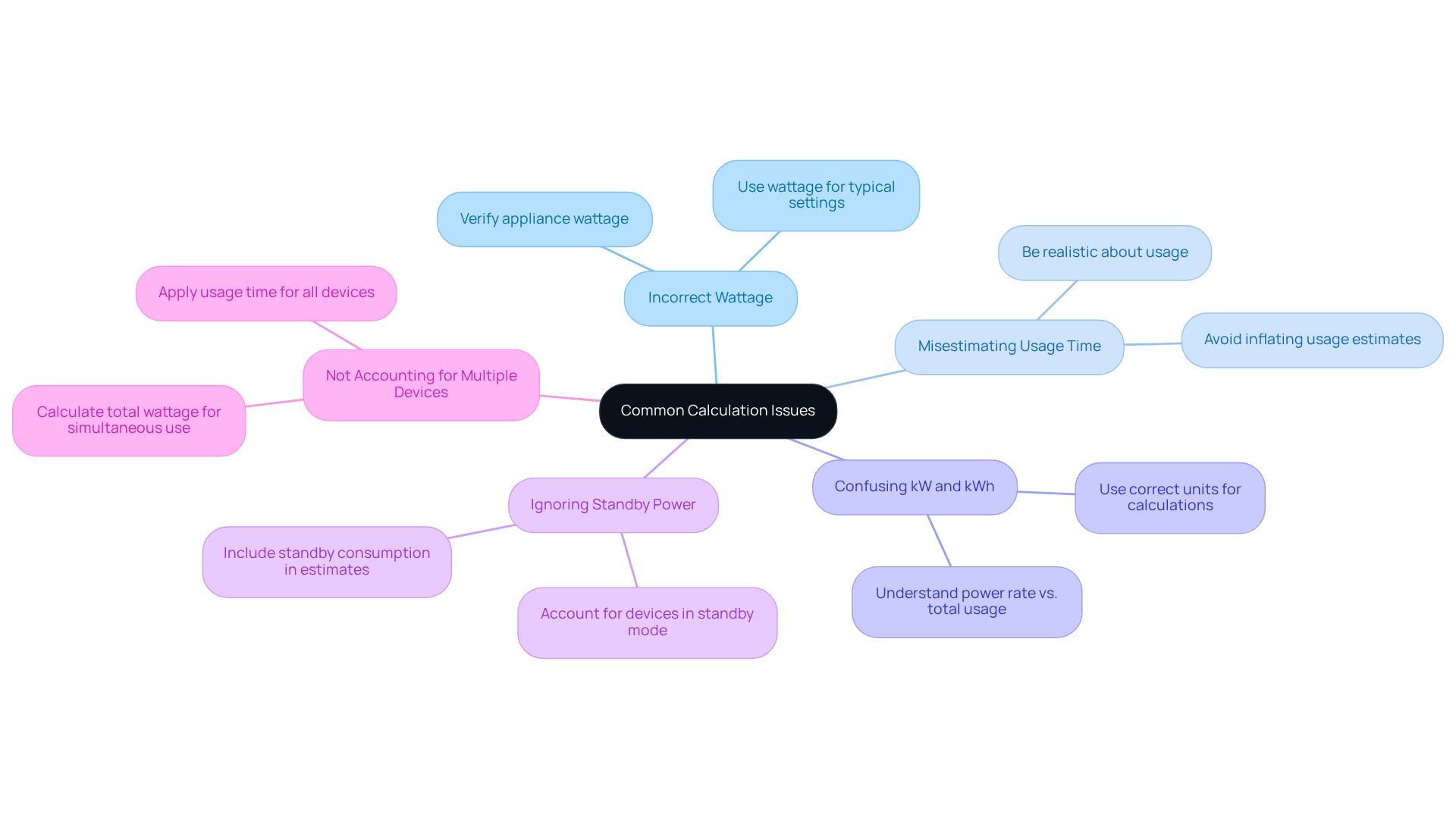Overview
Are you feeling overwhelmed by rising energy bills? You’re not alone. Many homeowners share this concern, and that’s why understanding how to calculate kilowatt hours (kWh) is so important. This guide is here to support you in managing your energy consumption and utility costs effectively. By detailing the calculation process, we emphasize the significance of knowing your appliances’ wattage and how long you use them. Understanding kWh not only empowers you to make informed energy-saving decisions but can also lead to reduced expenses and a more sustainable lifestyle.
Together, we can navigate this journey towards energy independence. Imagine the peace of mind that comes with knowing exactly how your energy usage impacts your bills. By taking control of your energy consumption, you can make choices that benefit both your wallet and the environment. Let’s explore the steps you can take to achieve this.
Start by assessing the wattage of your appliances and how often you use them. This simple yet effective method can illuminate areas where you can save energy. Remember, it’s common to feel uncertain about these calculations, but with a little guidance, you can become confident in managing your energy use.
As you gain a clearer understanding of kWh, you’ll find yourself equipped to make choices that align with your values of sustainability and cost savings. So, why not take the first step today? Together, we can work towards a brighter, more energy-efficient future.
Introduction
Understanding energy consumption is essential for homeowners who want to manage their electricity bills effectively. We know that rising energy costs can be a source of stress, and kilowatt hours (kWh) serve as a fundamental metric in this endeavor, representing the energy used by appliances over time. By mastering the calculation of kWh, homeowners can unlock significant savings and make informed decisions about their energy usage.
However, it’s common to feel overwhelmed by the complexities of these calculations. So, how can homeowners ensure accuracy in tracking their energy consumption and truly harness the benefits of understanding kilowatt hours? Together, we can explore solutions that empower you to take control of your energy habits and find peace of mind.
Understand Kilowatt Hours: Definition and Importance
We understand that navigating electricity bills can be daunting for homeowners. A kilowatt hour (kWh) is a unit of energy that quantifies electricity consumption, representing the energy used when a device rated at one kilowatt (1,000 watts) runs for a duration of sixty minutes. For property owners, grasping the concept of kWh is crucial, as it directly impacts your electricity bills.
For instance, did you know that a 100-watt light bulb left on for 10 hours consumes 1 kWh (100 watts x 10 hours = 1,000 watt-hours)? In California, the average household consumes approximately 491 kWh monthly, which translates to about 16.4 kWh daily. By tracking kWh consumption, residents can calculate kilowatt hours for high-consumption appliances, enabling them to make informed choices regarding efficiency. This awareness can lead to significant cost savings.
For example, households that implement energy-saving strategies, such as upgrading to ENERGY STAR-certified appliances or using smart thermostats, can substantially reduce their electricity bills. Recent studies indicate that residents can calculate kilowatt hours to effectively manage kWh usage, which can assist in lowering their monthly expenses and contribute to a more sustainable lifestyle.
Understanding kWh not only aids in budgeting for energy costs but also empowers homeowners to take control of their energy consumption, ultimately reducing their carbon footprint. Together, we can work towards a more energy-efficient future.
Calculate Kilowatt Hours: Step-by-Step Process
Understanding how to calculate kilowatt hours is essential for effectively managing your energy bills, although it can feel overwhelming. Let’s break it down together:
-
Identify the Appliance’s Wattage: Start by locating the wattage on your appliance’s label or in the manual. For example, a standard microwave typically uses around 1,000 watts. Knowing this helps you grasp how much energy your appliances consume.
-
Determine Usage Duration: Reflect on how often you use each appliance daily. If you use the microwave for 60 minutes each day, that’s your usage duration. It’s common to overlook this aspect, but it plays a significant role in your overall energy consumption.
-
Calculate Daily kWh: Use this simple formula:
kWh = (Wattage × Hours Used) ÷ 1,000
For the microwave, it would be: (1,000 watts × 1 hour) ÷ 1,000 = 1 kWh. This straightforward calculation can empower you to calculate kilowatt hours and thereby take control of your energy usage.
-
Calculate Monthly kWh: Multiply your daily kWh by the number of days in a month. If you use it daily, that’s 1 kWh × 30 days = 30 kWh per month. This insight can help you anticipate your utility costs more accurately.
-
Estimate Costs: Finally, to determine the cost, multiply your monthly kWh by your electricity rate. For instance, if your rate is $0.12 per kWh, then 30 kWh × $0.12 = $3.60. This knowledge allows you to budget more effectively.
By understanding how to calculate kilowatt hours, you can significantly influence your utility costs. For instance, tracking the usage of common appliances like refrigerators, which can consume between 100 to 400 watts, helps you identify high-energy-consuming devices. This awareness can lead to informed decisions about upgrades or replacements, fostering a more sustainable household.
Moreover, utilizing power monitors or plug-in watt meters can provide precise estimates of usage, aiding in efficient energy management. Simple routine upkeep, such as cleaning filters, can also help preserve efficiency and lower utility expenses.
Together, by implementing these calculations and practices, we can effectively manage our energy consumption and contribute to a more sustainable future. Let’s work towards making informed choices that benefit both our wallets and the planet.
Utilize Tools and Resources for Accurate Calculations
We understand that managing energy bills can be a significant concern for homeowners. To help you navigate this challenge, there are various tools and resources available that can empower you to take control of your energy consumption:
- Energy Consumption Calculators: Online platforms like SaveOnEnergy offer calculators where you can input your wattage and usage hours to effectively estimate your kWh consumption. When combined with Powercore Electric’s solar solutions, these calculators can guide you in maximizing your savings and achieving energy independence.
- Smart Meters: Many utility companies now provide smart meters that allow you to track your power usage in real-time. This insight enables you to observe your consumption habits and make adjustments as needed. By integrating solar power systems from Powercore Electric, you can further enhance your savings through informed resource management.
- Mobile Apps: Apps such as Energy Cost Calculator and HomeWizard Energy make it convenient for you to monitor and assess your power consumption directly from your smartphone. This accessibility helps you identify trends and uncover savings opportunities. When used alongside Powercore Electric’s power storage solutions, these applications can significantly boost your efficiency.
- Power Monitoring Tools: Devices like Sense can be installed in your electrical panel to provide detailed insights into your consumption patterns. This allows you to pinpoint high-usage appliances and improve your overall efficiency. When paired with a new roof from Powercore Electric, which protects your home and enhances energy efficiency, these tools can lead to substantial cost savings.
By utilizing these resources, you can calculate kilowatt hours to make informed choices that will lower your utility expenses and contribute to a more sustainable future. Together, we can work towards a brighter, more energy-independent tomorrow.
Troubleshoot Common Calculation Issues
When we calculate kilowatt hours, we recognize that homeowners may face several common issues that can result in inaccurate estimates. Here are some key points to consider:
- Incorrect Wattage: Always verify the wattage for the appliance in use. If the appliance has multiple settings, use the wattage for the setting you typically operate.
- Misestimating Usage Time: Be realistic about how long you use each appliance. Overestimating usage can inflate your kWh calculations, leading to unexpected costs.
- Confusing kW and kWh: Remember that kilowatts (kW) indicate the rate of power consumption, while kilowatt hours (kWh) quantify total power utilized over time. Using the correct units is crucial for accurate calculations.
- Ignoring Standby Power: Many devices utilize power even when not actively in use. Incorporating standby power consumption in your calculations will result in a more precise estimate of overall power usage.
- Not Accounting for Multiple Devices: If multiple devices are used simultaneously, you need to calculate kilowatt hours by determining the total wattage and then applying the usage time.
Statistics show that the typical U.S. household used 887 kilowatt-hours of electricity monthly in 2019, emphasizing the significance of precise calculations to control costs efficiently. Real-life instances demonstrate that rectifying wattage miscalculations has resulted in significant savings for numerous households, highlighting the importance of precise power monitoring. As Graham Lumley, Digital Marketing Manager at BKV Energy, notes, “Blockchain technology has the potential to revolutionize the way we manage and track kWh consumption.” By addressing these common pitfalls, we can work together to better manage energy consumption and potentially save significantly on electricity costs. Remember, together we can navigate these challenges and find solutions that empower your energy independence.
Conclusion
Understanding kilowatt hours (kWh) is essential for homeowners who may feel overwhelmed by rising energy costs and seeking to manage their energy consumption effectively. By grasping how kWh operates and its impact on electricity bills, you can take control of your energy usage, leading to informed decisions that promote efficiency and sustainability. This knowledge empowers you not only to budget better but also to contribute to a greener future.
We understand that navigating energy consumption can be daunting. The article outlines a clear step-by-step process for calculating kilowatt hours, emphasizing the importance of:
- Identifying appliance wattage
- Estimating usage duration
- Applying simple formulas to derive daily and monthly kWh figures
It also highlights various tools and resources, such as:
- Energy consumption calculators
- Smart meters
- Mobile apps
These can aid in accurately tracking and managing your energy use. Additionally, addressing common calculation issues ensures that you can avoid pitfalls that may lead to inflated energy costs.
Ultimately, the journey towards energy independence begins with understanding and managing kilowatt hours. By implementing the strategies discussed, you can make significant strides in reducing your utility expenses while promoting a sustainable lifestyle. Embracing these practices not only enhances your financial health but also contributes to the broader goal of energy efficiency and environmental stewardship. Together, we can take action today to pave the way for a brighter, more sustainable tomorrow.






